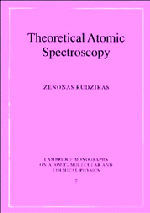Book contents
- Frontmatter
- Contents
- Preface
- Foreword to the Paperback Edition
- Introduction
- Part 1 Energy Spectrum of Many-electron Atom. Radiative and Autoionizing Transitions (Initial Formulas)
- Part 2 Foundations of the Angular Momentum Theory. Graphical Methods
- Part 3 Description of Complex Electronic Configurations
- Part 4 Second-quantization in the Theory of an Atom. Quasispin and Isospin
- Part 5 Matrix Elements of the Energy Operator
- 19 The energy of a shell of equivalent electrons
- 20 Interaction energy of two shells in LS coupling
- 21 Semi-empirical methods of calculation of the energy spectra
- 22 Hyperfine structure of the energy spectra, isotopic and Lamb shift
- 23 Quasispin and isospin for relativistic matrix elements
- Part 6 Electric and Magnetic Multipole Transitions
- Part 7 Calculation of Energy Spectra and Electronic Transitions in the Case of Complex Configurations
- Epilogue
- References
- Index
22 - Hyperfine structure of the energy spectra, isotopic and Lamb shift
Published online by Cambridge University Press: 21 September 2009
- Frontmatter
- Contents
- Preface
- Foreword to the Paperback Edition
- Introduction
- Part 1 Energy Spectrum of Many-electron Atom. Radiative and Autoionizing Transitions (Initial Formulas)
- Part 2 Foundations of the Angular Momentum Theory. Graphical Methods
- Part 3 Description of Complex Electronic Configurations
- Part 4 Second-quantization in the Theory of an Atom. Quasispin and Isospin
- Part 5 Matrix Elements of the Energy Operator
- 19 The energy of a shell of equivalent electrons
- 20 Interaction energy of two shells in LS coupling
- 21 Semi-empirical methods of calculation of the energy spectra
- 22 Hyperfine structure of the energy spectra, isotopic and Lamb shift
- 23 Quasispin and isospin for relativistic matrix elements
- Part 6 Electric and Magnetic Multipole Transitions
- Part 7 Calculation of Energy Spectra and Electronic Transitions in the Case of Complex Configurations
- Epilogue
- References
- Index
Summary
Hyperfine interactions in non-relativistic approximation
The hyperfine structure (splitting) of energy levels is mainly caused by electric and magnetic multipole interactions between the atomic nucleus and electronic shells. From the known data on hyperfine structure we can determine the electric and magnetic multipole momenta of the nuclei, their spins and other parameters.
In a non-relativistic approximation the usual fine structure (splitting) of the energy terms is considered as a perturbation whereas the hyperfine splitting – as an even smaller perturbation, and they both are calculated as matrix elements of the corresponding operators with respect to the zero-order wave functions.
The representation of hyperfine interactions in the form of multipoles follows from expansion of the potentials of the electric and magnetic fields of a nucleus, conditioned by the distribution of nuclear charges and currents, in a series of the corresponding multipole momenta. It follows from the properties of the operators obtained with respect to the inversion operation that the nucleus can possess non-zero electric multipole momenta of the order k = 0,2,4,…, and magnetic ones with k = 1,3,5,…. The energy of the hyperfine interactions decreases rapidly with the increase of multipolarity, therefore, it is usually enough to take into consideration only the first non-zero term in the expansion over multipoles. However, in a number of cases, due to the existence of selection rules and other effects, the higher multipoles must be accounted for. Indeed, in the hexadecapole nuclear momentum for 165Ho was found.
As usual, the operators describing hyperfine interactions are to be expressed in terms of irreducible tensors. Then we are in a position to find formulas for their matrix elements.
- Type
- Chapter
- Information
- Theoretical Atomic Spectroscopy , pp. 261 - 272Publisher: Cambridge University PressPrint publication year: 1997



